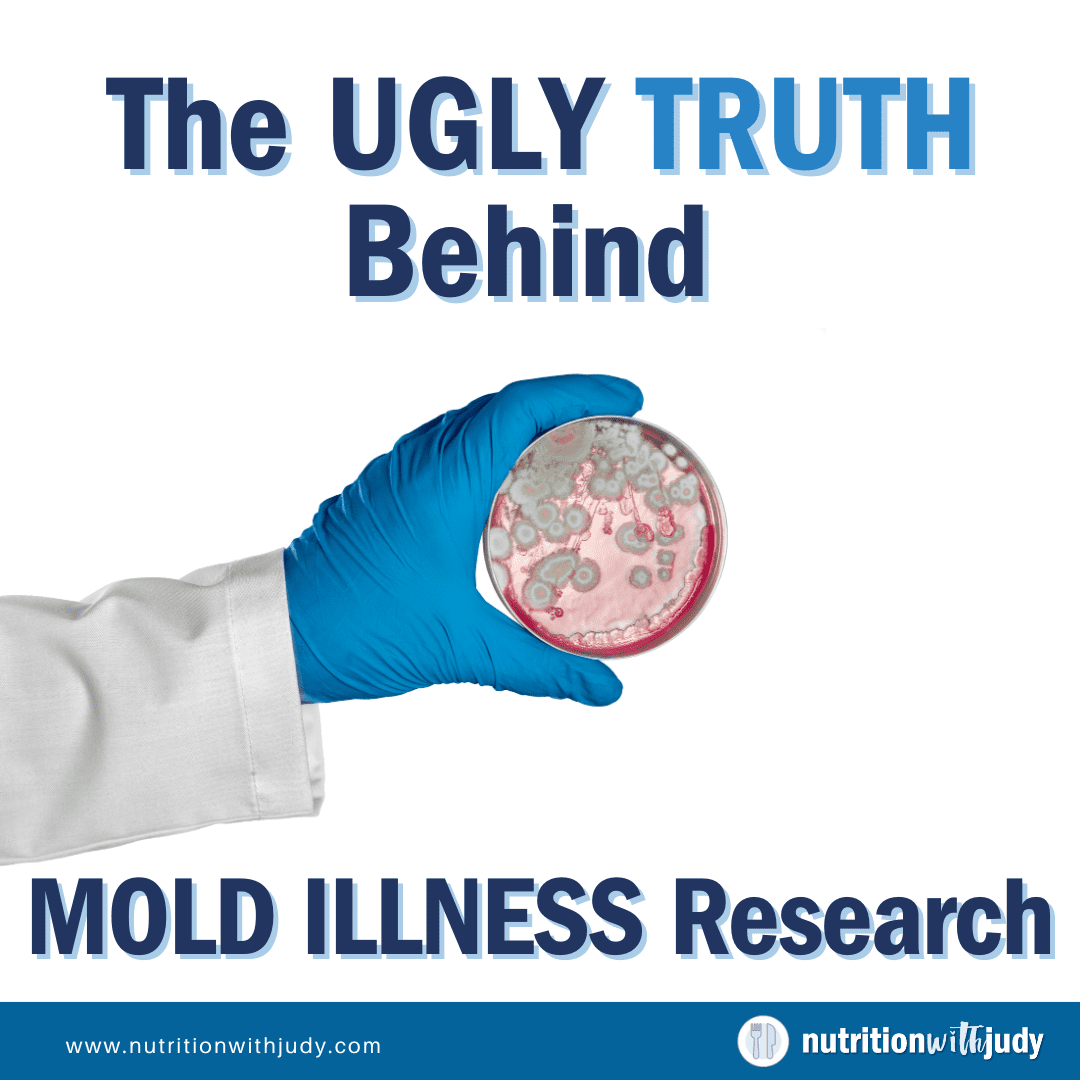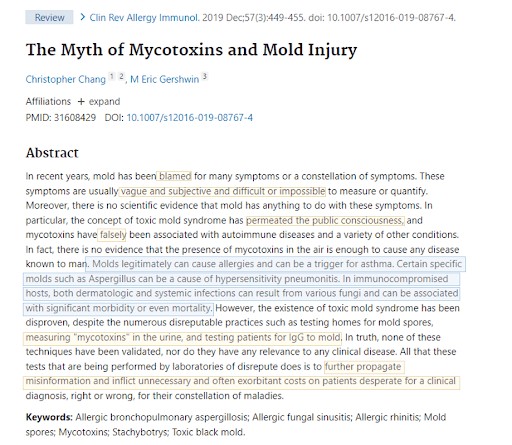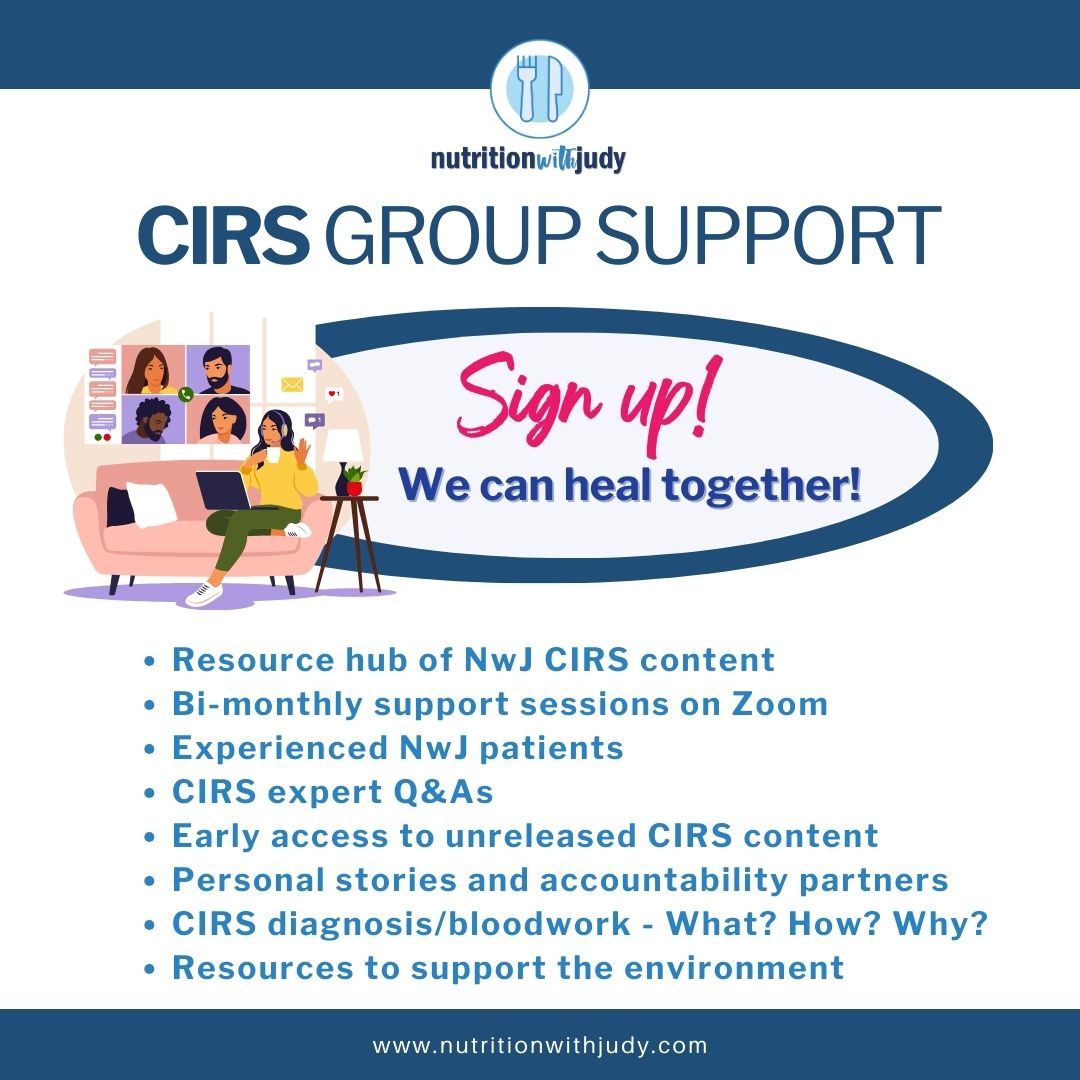

The Ugly Truth Behind Mold Illness Research


Original Publish Date: 5/6/23
This week a person shared that mold illness is a social media construct. This person shared the study, “The Myth of Mycotoxins and Mold Injury,” by Christopher Chang from UC Davis.
If you’ve been here long enough, you know I’m very inquisitive. As a writer, I understand how critical written words matter. So I want to know why an unbiased study would use the word myth. The abstract of this paper screams words of bias from the start.
Words can push a narrative.
The title of the study sounds as if mycotoxin and mold injury are fake. It’s a myth.
Myth – noun: an unfounded or false notion
So if I just read the headline, injuries from mold are false.
But even within the abstract (see below, highlighted in blue) he states, “Molds legitimately can cause allergies and can be a trigger for asthma. Certain specific molds such as Aspergillus can be a cause of hypersensitivity pneumonitis. In immunocompromised hosts, both dermatologic and systemic infections can result from various fungi and can be associated with significant morbidity or even mortality.” (Source)
—
Mold is fungi.
Mycotoxins are toxic compounds produced by fungi (mold).
“Various fungi and can be associated with significant morbidity or even mortality,” but mold injury is a myth??
Sigh.


The fact that a prominent practitioner shared this “study” is absurd.
Below are some other fear-mongering headliners.
“Separating fact from fantasy,” “Mass hysteria” and “Mold hysteria: origin of the hoax” (Source)


Now I have to know who this Christopher Chang is, and how he’s publishing papers with these inciting words.
Ah, he has thousands of studies with his name. What do you know, he’s:
- Editor-in-Chief of the Journal of Evidence-Based Integrative Medicine
- Co-editor of the Journal of Translational Autoimmunity
- Associated Editor of Clinical Reviews in Allergy and Immunology
Could any evidence-based or peer-reviewed mold or water-damaged building get published in these papers? We clearly know where the editor stands with fake mold—the mythical mold that can cause death.
I want to dig into this so much more, but I am juggling many big projects, so I’ll share some thoughts quick thoughts here:
1. Asthma in children and adolescents: a comprehensive approach to diagnosis and management (Source)
In 2012, he wrote a paper on how to support asthma in children. In Figure 4, he shares how to support asthma from molds. He was the sole author.


2. Impact of Air Pollution on Atopic Dermatitis: A Comprehensive Review (Source)
In 2023, he published a paper on how air pollution causes skin issues. Air pollution is caused by many things including particulate matter (mold fragments?). The damage is done to the skin through oxidative stress, triggering immune dysregulation and enhanced sensitization to allergens.
Air pollution, whether in the home or not, could trigger immune dysregulation via oxidative stress (per this study).


Fine. You can say I’m conflating air pollution and air in water-damaged buildings. But… he has a paper published in 1993 where he talks about sick building syndrome and poor indoor air quality.
3. The sick building syndrome. II. Assessment and regulation of indoor air quality (Source)
“Indoor air pollution is closely associated with health problems and exacerbation of asthmatic symptoms.” (Source)


I’m not sure if Christopher Change doesn’t remember all the studies he published but how can he say mold illness is fake?
His own research disproves his case. Sorry, Mr. Chang, mold illness is NOT a myth.
The CIRS community of Dr. Shoemaker agrees that mycotoxin urine tests are not ideal. Why would they be? What’s the control? Is any release a healthy response? Compared to who? If you have to force yourself to take glutathione to shake things up, at what point are you completely free of mycotoxins? Is a cleared amount truly clear, or if you took another 500 mg of glutathione, would you show more?
Tsk tsk.
I agree that urine mycotoxin tests are not a good sole diagnostic tool for mold illness.
Shoemaker uses bloodwork, genetic testing, and MRI scans. These are measurable and trackable diagnostic tools.


Unclear mold symptoms?
No, there is a strict diagnostic criteria for CIRS.


Unclear sick building allergens?
False. Here’s a list below.


Here’s a study from a fellow Shoemaker practitioner, Ming Dooley, who has done 1000+ hours of research to find the best evidence-based research on mold illness, “A comprehensive review of mold research literature from 2011 – 2018”
Conclusion: “Of 114 epidemiological articles, 112 (98.2%) were supportive of single/multi-system symptoms. The current literature supports multi-system adverse human health effects in those chronically exposed to indoor microbial growth/dampness.” (Source)
Now CIRS is not just about mold. It can be other biotoxins such as bacteria, recluse spider bites, Lyme, and much more. It’s essentially when the immune system has gone awry and can’t turn itself off.
—
💡 Pro-Tip: Moldy food can have issues too (but it’s not CIRS). One study showed liver aflatoxin (mold)-related liver cancer (Source). If you’re still anemic on a carnivore diet, consider parasites, h-pylori, and ochratoxin A (mold). (Source)
Always do your own research. Just because a prominent doctor or practitioner is in our wellness space, doesn’t mean you can wholly trust them (including me.) Ask for receipts and then scan them closely.
Call it what you want, but when I see blood markers and symptoms drastically improve with the carnivore diet + CIRS treatment, no amount of myths, hysteria, and fantasy will make me unsee what I’ve seen in healing.
“First they ignore you, then they ridicule you, then they fight you, and then you win.” – Mahatma Gandhi
CIRS Support


For individuals seeking comprehensive practitioner-led and community support on their mold illness journey, we welcome you to join our exclusive NwJ CIRS Group Support. Join today for access to extensive resources, a like-minded community, and unparalleled care as we journey to root-cause healing together.
In health,
Judy




Chassidy Terrian
January 22, 2024 at 5:00 pmHello there, just became aware of your blog through Google, and found that it’s truly informative. I’m gonna watch out for brussels. I’ll appreciate if you continue this in future. Lots of people will be benefited from your writing. Cheers!
Dan Gibbons
February 29, 2024 at 8:15 pmI mean, it’s fairly obvious from the abstract (in the parts not highlighted by the blog’s author) that the study author is referencing a recent practice where mold is cited as the causative agent for a host of ailments beyond what the evidence supports (the paper referenced toxic mold syndrome as an example). The study author does not reject the fact that mold can cause disease, but rather the practice where patients and actors in the medical community have wrongfully identified (and constructed) mold as a ubiquitous pathogen in our lives.